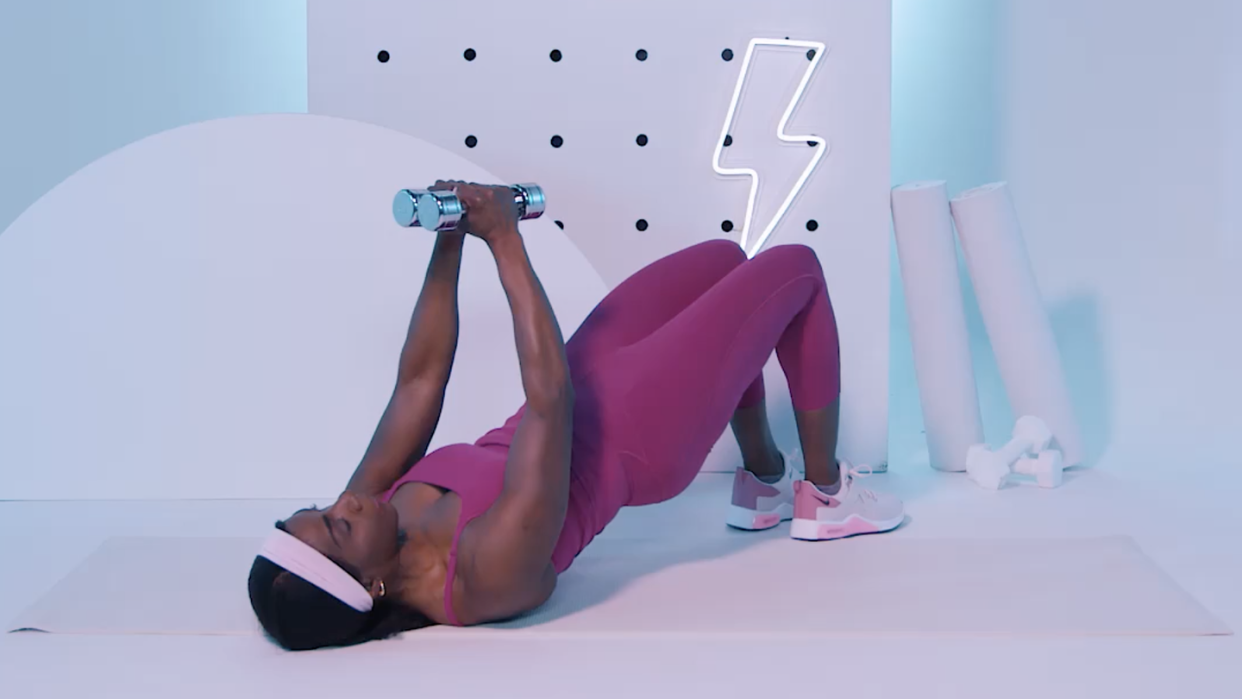Trainers Say These 5 Tricks Are Key For Strengthening Your Chest

It can be easy to default to biceps, triceps, and shoulder exercises on upper body workout days. I know I'm guilty of it. But you're missing an important muscle group: the chest. Working the chest (or pectoral muscles) is an important part of a holistic strength-training routine.
"Many women tend to neglect the muscle group, emphasizing lower-body movements and forgetting that the chest and back require the same attention," explains Elise Young, CPT, CFSC, of Elise's Bodyshop. It's not just about lifting the chest, either. There are many additional benefits of strong pecs.
Not only will your posture improve from working the chest, but these exercises will also make daily functions a lot easier (like carrying groceries, dragging furniture up a six-floor walk-up, or participating in a pushup contest). Plus, they can also strengthen your muscles to the point of preventing neck and back injuries. And who doesn’t want that?
Meet the experts:
Elise Young, CPT, CFSC, is a certified personal trainer and founder of Elise's Bodyshop.
Mike Simone, CPT, is the founder of humanfitproject.
Taylor Rae Almonte-Roman, CPT, is a New York City-based boxing coach and former founding trainer of Fiture.
Another fun fact: The best chest exercises work more than just your chest. The moves that involve pushing also recruit your shoulders, core, back, and triceps. "I always hear, 'what can I do for triceps?' and although there are specific triceps exercises, the best way to work the triceps is going to be through compound pushing motions such as chest presses and pushups," says Young.
Read on to learn about the muscles that make up the chest, tips for starting chest exercises, and how to do the most effective chest exercises for a strong upper bod.
The Chest Muscles, Explained
The chest is made up of the pec major, pec minor, and serratus anterior. Here, Young breaks them down.
Pectoralis major: The largest of the chest muscles, this fan-shaped muscle spans across your chest. It is responsible for flexion, adduction, and internal rotation of the humerus (arm at the glenohumeral joint, a.k.a. the shoulder).
Pectoralis minor: Smaller and with a more triangular shape, this muscle serves many functions, such as moving the ribs and shoulder blades.
Serratus anterior: More laterally located within the chest wall, this muscle is responsible for scapular protraction (translation: pushing away from your body).
Pro Tips For Strengthening Your Chest
Retract your scapula. Essentially, you want to think about pulling your shoulder blades down and back. "Retracting your scapula requires full recruitment of your chest muscles for the specific pushing movement," Young explains.
Pair chest moves with lower-body pulling moves. “I prefer to work in full-body strength-based training so I balance my training with lower-body push (think squats, lunges) paired with upper-body pull (think rows) and lower-body pull (think deadlifts, bridges) with upper-body push,” says Young. “When we think of upper-body push we are focusing on pushing away from the body."
Start with a barbell. It may sound counterintuitive but Young suggests doing chest presses with a bar (sans any added weight!), rather than dumbbells, when you’re first starting out. “It is often challenging to maintain control with dumbbells so you can focus on using a bar to create that control,” she explains.
Don’t do pushups on your knees. “I highly suggest elevating your upper body on a bench, couch, or chair before dropping to your knees,” Young says. “When we drop to our knees on an exercise such as pushups, we are losing our full core function and therefore it becomes more difficult to progress the exercise. Pushups require a ton of core control, so the more we can practice the same motion, even from an elevated surface, the quicker we will get stronger.”
Consider tempo training. Once you master a particular chest exercise, consider switching up your tempo, or how long it takes you to execute the three components of the movement, says Mike Simone, CPT, founder of Human Fit Project: There is the concentric, or “upward,” phase of the movement, like popping back up to plank from a push-up. Next, there is the eccentric (or “lowering phase), as well as the isometric, when you’re holding a move in peak contraction.
The 20 Best Chest Exercises
Time: 20–25 minutes | Equipment: dumbbells, mat | Good for: chest, arms, upper body
Instructions: Choose 5 to 8 moves below. After a quick dynamic warm-up, perform 10 to 12 reps of each (or as many reps as possible in 50 seconds), rest for 15 seconds, then continue to the next exercise. Once you've completed each exercise once, rest for 1 minute, then repeat the entire circuit twice more for a total of three rounds. Consider alternating chest moves with lower-body pulling moves like deadlifts for a total-body workout.
You Might Also Like

